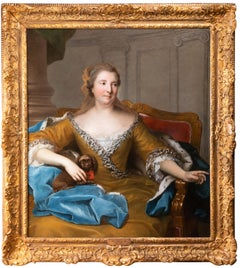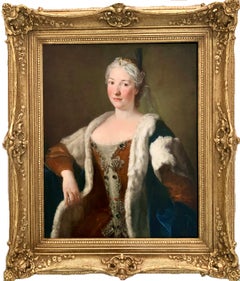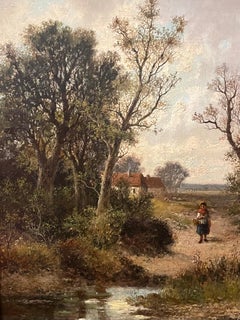Jean-Marc Nattier Paintings
to
1
Overall Width
to
Overall Height
to
1
1
1
1
1
1
1
1
1
1
1
2
784
705
692
691
1
1
Artist: Jean-Marc Nattier
Jean-Marc Nattier (1685 - 1766) - Portrait of Charlotte de Hesse-Rheinfels
By Jean-Marc Nattier
Located in PARIS, FR
Jean-Marc Nattier (Paris, 1685 - 1766) and his workshop
Portrait of Charlotte de Hesse-Rheinfels
Oil on canvas : h. 44.09 in, w. 38.19 in
18th century carved giltwood framed
Fra...
Category
1730s Old Masters Jean-Marc Nattier Paintings
Materials
Canvas, Oil
Related Items
18th century French Old Master Portrait of a woman in oriental costume
Located in Aartselaar, BE
French 18th century old master portrait of a majestic lady dressed "à la Turque"
The sitter at the viewer with a kind and enigmatic smile and twinkling eyes. She looks elegant and kind, yet also has an intelligent and determined aura, reflecting the character of someone who is in charge of her own life and destiny.
De Silvestre paid great attention to her spectacular outfit, which is striking in its portrayal of the sumptuous fabrics and their decorative richness. She is wearing a luxurious royal blue robe à la...
Category
1740s Old Masters Jean-Marc Nattier Paintings
Materials
Canvas, Oil
$22,165
H 31.89 in W 25.6 in D 0.4 in
Landscape Near Felday, Surrey
By Abraham Hulk the Younger
Located in Hillsborough, NC
Dutch/English artist Abraham Hulk the Younger (1851-1922) is most known for landscapes of the British countryside. This work is one of a pair (the second work is also available by s...
Category
Late 19th Century Old Masters Jean-Marc Nattier Paintings
Materials
Canvas, Oil
$2,240 Sale Price
20% Off
H 27 in W 22.75 in D 2.13 in
Men Fraternizing with Ladies, Pre-20th Cen Oil Painting by Wilfrid Beauquesne
By Wilfrid Constant Beauquesne
Located in Long Island City, NY
Artist: Wilfrid Constant Beauquesne, French (1840 - 1913)
Title: Men Fraternizing with the Ladies
Year: c. 1890
Medium: Oil on Canvas, signed l.l.
Size: 21.5 x 26 in. (54.61 x 66.04 ...
Category
1890s Old Masters Jean-Marc Nattier Paintings
Materials
Canvas, Oil
Mid 19th Century "Susanna And The Elders" After The Old Master by Martinelli
Located in San Francisco, CA
Outstanding Mid 19th century old master "Susanna and the Elders" after Martinelli
Brilliant old master painting of Susanna and the Elders.
Original oil on canvas. Dimensions 26.5" ...
Category
Mid-19th Century Old Masters Jean-Marc Nattier Paintings
Materials
Canvas, Oil
$1,950 Sale Price
58% Off
H 36 in W 26.5 in D 3 in
17th Century by Il Padovanino Mary Magdalene or Young Woman Oil on Canvas
Located in Milano, Lombardia
Alessandro Leone Varotari, known as Il Padovanino (Padua, Italy, 1588 – Venice, Italy, 1649)
Title: Mary Magdalene or Young Woman
Medium: Oil on canvas
Dimensions: Without frame 50.5...
Category
17th Century Old Masters Jean-Marc Nattier Paintings
Materials
Canvas, Oil
$37,262
H 19.89 in W 29.93 in D 0.6 in
17th Century by Pietro Della Vecchia The Alchemists Oil on canvas
Located in Milano, Lombardia
Pietro Della Vecchia (Venice, Italy, 1603 - Vicenza, Italy, 1678)
Title: The Alchemists
Medium: Oil on canvas
Dimensions: without frame 73 x 97 cm – with frame 90.4 x 114.3 x 6 cm
...
Category
17th Century Old Masters Jean-Marc Nattier Paintings
Materials
Canvas, Oil
Pietro Della Vecchia 17th Century by Pietro Della Vecchia The Alchemists Oil on canvas, 17th Century
$146,532
H 28.75 in W 38.19 in
Shipping in Stormy Waters, Attributed to Italian Artist Francesco Guardi
By Francesco Guardi
Located in Stockholm, SE
The splendour of the tragic sea
Francesco Guardi and maritime painting in Venetian art
No Venetian painter was a stranger to the sea. After all, Venice was not only one of the most prominent ports of the Mediterranean, but indeed a city literally submerged in the ocean from time to time. Curiously however, the famous Venetian school of painting showed little interest in maritime motifs, favouring scenes from the iconic architecture of the city rather than seascapes. That is why this painting is a particularly interesting window into not only the painter Francesco Guardi himself – but to the significance of the element of water in art history, in absence as well as in the centre of attention.
Whether it be calm, sunny days with stunning views of the palaces alongside the canals of Venice or – more rarely – stormy shipwrecking tragedies at sea, water as a unifying element is integral to the works of painter Francesco Guardi (1712–1793). During his lifetime, Venetian art saw many of its greatest triumphs with names like Tiepolo or Canaletto gaining international recognition and firmly establishing Venice as one of the most vibrant artistic communities of Europe. While the city itself already in the 18th century was something of an early tourist spot where aristocrats and high society visited on their grand tour or travels, the artists too contributed to the fame and their work spread the image of Venice as the city of romance and leisure to an international audience, many of whom could never visit in person.
Still today, the iconic image of Venice with its whimsical array of palaces, churches and other historic buildings is much influenced by these artists, many of whom have stood the test of time like very well and remain some of the most beloved in all of art history. It was not primarily subtility, intellectual meanings or moral ideals that the Venetian art tried to capture; instead it was the sheer vibrancy of life and the fast-paced city with crumbling palaces and festive people that made this atmosphere so special. Of course, Venice could count painters in most genres among its residents, from portraiture to religious motifs, history painting and much else. Still, it is the Vedutas and views of the city that seems to have etched itself into our memory more than anything else, not least in the tradition of Canaletto who was perhaps the undisputed master of all Venetian painters.
Born into his profession, Francesco lived and breathed painting all his life. His father, the painter Domenico Guardi (1678–1716) died when Francesco was just a small child, yet both he and his brothers Niccolò and Gian Antonio continued in their fathers’ footsteps. The Guardi family belonged to the nobility and originated from the mountainous area of Trentino, not far from the Alps. The brothers worked together on more challenging commissions and supported each other in the manner typical of family workshops or networks of artists. Their sister Maria Cecilia married no other than the artist Giovanni Battista Tiepolo himself, linking the family to the most renowned Venetian name of the time. During almost a decade, Guardi worked in the studio of Michele Giovanni Marieschi, sometimes simply known as Michiel, a painted similar in both style and motif. Canaletto is, however, the artist Guardi is most often compared to since they shared a mutual fascination for depicting the architecture and cityscape of Venice.
During the course of his career, Guardi tried his hand in many different genres. He was as swift in painting landscapes, Vedutas of Venice, sacred motifs, interiors and architectural compositions as he was in a number of other motifs. His style is typical of the Venetian school but also distinct and personal once we look a little closer. There is an absolute certainty in the composition, the choice of which sometimes feels like that of a carefully calculated photograph – yet it is also very painterly, in the best sense of the word: fluid, bold, sensitive and full of character. The brushwork is rapid, intense, seemingly careless and extraordinarily minute at the same time; fresh and planned in a very enjoyable mixture. His interiors often capture the breath-taking spacious glamour of the palaces and all their exquisite decor. He usually constructed the motif through remarkably simple, almost spontaneous yet intuitively precise strokes and shapes. The result was a festive, high-spirited atmospheric quality, far away from the sterile and exact likeness that other painters fell victim to when trying to copy Canaletto.
The painting here has nothing of the city of Venice in it. On the contrary, we seem to be transported far away into the solitary ocean, with no architecture, nothing to hold on to – only the roaring sea and the dangerous cliffs upon which the ships are just moments away from being crushed upon. It is a maritime composition evoking both Flemish and Italian precursors, in the proud tradition of maritime painting that for centuries formed a crucial part of our visual culture.
This genre of painting is today curiously overlooked, compared to how esteemed and meaningful it was when our relationship to the sea was far more natural than it is today. When both people and goods travelled by water, and many nations and cities – Venice among them – depended entirely on sea fare, the existential connection to the ocean was much more natural and integrated into the imagination. The schools and traditions of maritime art are as manifold as there are countries connected to the sea, and all reflect the need to process the dangers and wonders of the ocean.
It could symbolize opportunity, the exciting prospects of a new countries and adventures, prospering trade, beautiful scenery as well as war and tragedy, loss of life, danger and doom. To say that water is ambivalent in nature is an understatement, and these many layers were something that artists explored in the most wondrous ways. Perhaps it takes a bit more time for the modern eye to identify the different nuances and qualities of historic maritime paintings, they may on first impression seem hard to differentiate from each other. But when allowing these motifs to unfold and tell stories of the sea in both fiction and reality – or somewhere in between – we are awarded with an understanding of how the oceans truly built our world.
In Guardi’s interpretation, we see an almost theatrically arranged shipwrecking scene. No less than five ships are depicted right in the moment of utter disaster. Caught in a violent storm, the waves have driven them to a shore of sharp cliffs and if not swallowed by the waves, crushing against the cliffs seems to be the only outcome. The large wooden ships are impressively decorated with elaborate sculpture, and in fact relics already during Guardi’s lifetime. They are in fact typical of Dutch and Flemish 17th century ships, giving us a clue to where he got the inspiration from. Guardi must have seen examples of Flemish maritime art, that made him curious about these particular motifs. One is reminded of Flemish painters like Willem van de Velde and Ludolf Backhuysen, and this very painting has indeed been mistakenly attributed to Matthieu van Plattenberg...
Category
18th Century Old Masters Jean-Marc Nattier Paintings
Materials
Canvas, Oil
$47,805 Sale Price
32% Off
H 25.79 in W 29.14 in
YOUTH AND WISDOM Ciro De Rosa Italian School - Italy Figurative Oil on painting
By Ciro De Rosa
Located in Napoli, IT
Youth and wisdom -Ciro De Rosa Italia 2007 - Oil on canvas cm.60x50
Gold leaf gilded wooden frame cm.82x73 available on request
The painting by Ciro De Rosa is characterized by light...
Category
Early 2000s Old Masters Jean-Marc Nattier Paintings
Materials
Canvas, Oil
$3,594
H 23.63 in W 19.69 in
19th century English Portrait of a Young boy in a Cavalier costume
Located in Woodbury, CT
This elegant English 19th-century portrait of a young boy dressed in a Cavalier costume, painted circa 1860, is a striking example of Victorian portraiture that seamlessly combines h...
Category
1860s Old Masters Jean-Marc Nattier Paintings
Materials
Canvas, Oil
17th century follower of Rubens, two military men on horse back in a landscape
Located in Woodbury, CT
17th century English/Dutch School, from the Circle of Sir Peter Paul Rubens
A very interesting and well-painted 17th-century oil on canvas of two men seated on horseback in a landsc...
Category
1680s Old Masters Jean-Marc Nattier Paintings
Materials
Canvas, Oil
$8,050 Sale Price
30% Off
H 16 in W 22 in
19th Century English Antique, Two Country farmers drinking beer in a landscape
By George Morland
Located in Woodbury, CT
Attributed to George Morland.
19th Century English Antique, Two Country farmers drinking beer in a landscape.
Wonderful early 19th-century original oil on canvas.
A classic 'Morland' composition as the painter was a big fan of English Pub scenes...
Category
Early 1800s Old Masters Jean-Marc Nattier Paintings
Materials
Canvas, Oil
$3,160 Sale Price
20% Off
H 20 in W 16 in
The Grape Seller - Workshop of Jacob Ochtervelt
Located in Stockholm, SE
Jacob Ochtervelt (Workshop)
The Grape Seller
oil on canvas
unframed: 80.7 x 61 cm.; 31 ¾ x 24 in.
framed: 109.5 x 89 cm.; 43 1/8 x 35 in.
Essay:
This captivating piece, originating from the studio of the revered Dutch artist Jacob Ochtervelt, mirrors the composition of a signed and dated 1669 canvas by Ochtervelt that is presently housed in the Hermitage museum. Its subject, "The Grape Seller" immerses us in a typical 17th-century interior, replete with characters from various strata of society.
At the center, a fruit vendor is depicted bending over to weigh grapes for the buyer. A child hands some of the grapes to her mother to taste, their attentive maid standing by. The backdrop showcases typical Ochtervelt details: a hint of the city visible through the doorway, light filtering in through an overhead window, and a playful dog at their side.
The exquisite quality of the piece is evident in the minutiae, such as the intricate detailing of the mother's earring, which in reality spans only a few millimeters yet boasts impressive attention to detail. Initially, Sotheby's considered this work to be an autograph piece by Ochtervelt. But due to some uncertainty, it was auctioned as Workshop of Jacob Ochtervelt. On the other hand, the esteemed Cabinet Turquin in Paris leans toward attributing the piece directly to Jacob Ochtervelt himself.
The painting is framed in an authentic period frame, which has been delicately restored by Stockholm's Förgyllning och Bildhuggeri. The frame retains its age-old patina and, while in used condition, has minor imperfections adding to its charm.
Another interesting thing worth to mention is the painting's provenance. It was once owned by the 1st Viscount Rothermere (1868-1940), the founder of the Daily Mail and Daily Mirror...
Category
17th Century Old Masters Jean-Marc Nattier Paintings
Materials
Canvas, Oil
Jean-marc Nattier paintings for sale on 1stDibs.
Find a wide variety of authentic Jean-Marc Nattier paintings available for sale on 1stDibs. You can also browse by medium to find art by Jean-Marc Nattier in canvas, fabric, oil paint and more. Much of the original work by this artist or collective was created during the 18th century and is mostly associated with the Old Masters style. Not every interior allows for large Jean-Marc Nattier paintings, so small editions measuring 48 inches across are available. Customers who are interested in this artist might also find the work of Paul Emile Léon Perboyre, Sir Godfrey Kneller, Flemish School, and 17th Century. Jean-Marc Nattier paintings prices can differ depending upon medium, time period and other attributes. On 1stDibs, the price for these items starts at $61,020 and tops out at $61,020, while the average work can sell for $61,020.


